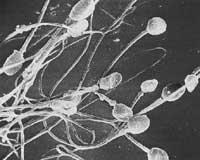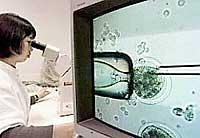The ice cream of human eggs awakens hope
2001/02/27 Galarraga Aiestaran, Ana - Elhuyar Zientzia

Raffaella Fabri and her team at the University of Bologna have discovered what are the key players in the freeze-thawing process. In laboratory trials, the eggs have survived much more than the previous technique and have fertilized 57% of the eggs using the ICSI technique, that is, the injection of the sperm into the egg. In the fertilization of fresh eggs, similar figures are also obtained.
Two are the keys to this achievement: on the one hand, that the egg passes from 10 minutes to 15 minutes under the action of chemical protectors (propanodiol and glucose) and, on the other, that the amount of glucose is duplicated or triplique. During the freezing process, the eggs are destroyed by inadequate dehydration, but the freezing process is softer and the formation of ice crystals that can pierce the cell membrane is avoided.
In addition, until now the cells surrounding and feeding the egg (cumulus oophurus) were considered to be a very important agent. However, the eggs to which the cumulus oophurus has been completely or partially removed have seen that they persist equally. Thus it has been shown that this cell group has less importance than they thought.
With this gentle freezing process and using the ICSI technique, 90%, two or three days after the fertilized ovum, arrive at the situation of the morula, giving it a viable potential certainty. In addition, they have seen that three-quarters of the embryos are in a very good or quite good state.
It can also be an alternative method in those cases where due to defects of the ovular membrane there are problems of fertilization. This is because although membrane defects prevent the inrush of sperm, this method allows to inject the sperm into the egg, so the problem can be avoided.
Raffaella Fabri hopes to use this technique in most centers around the world, as it could help meet the expectations of many couples. In addition, it prevents the freezing of embryos and the excess of embryos.

Gai honi buruzko eduki gehiago
Elhuyarrek garatutako teknologia





